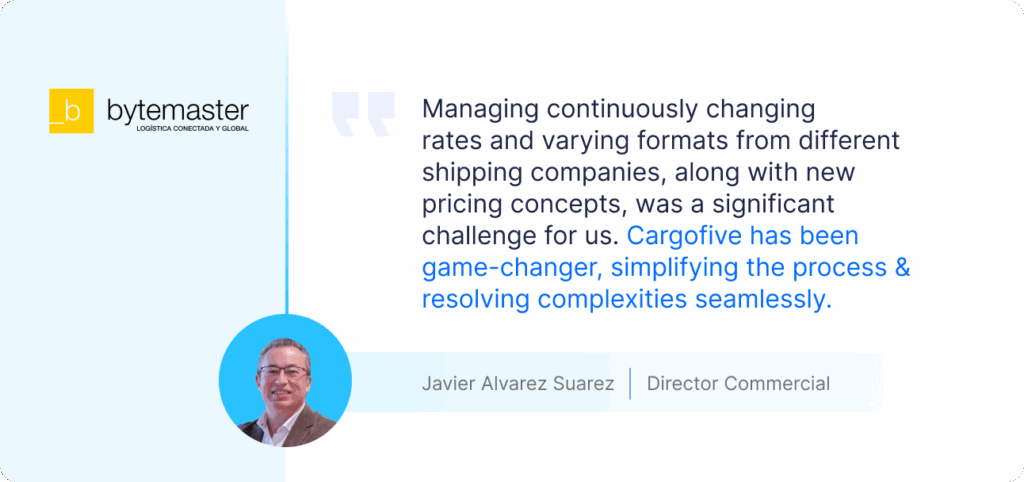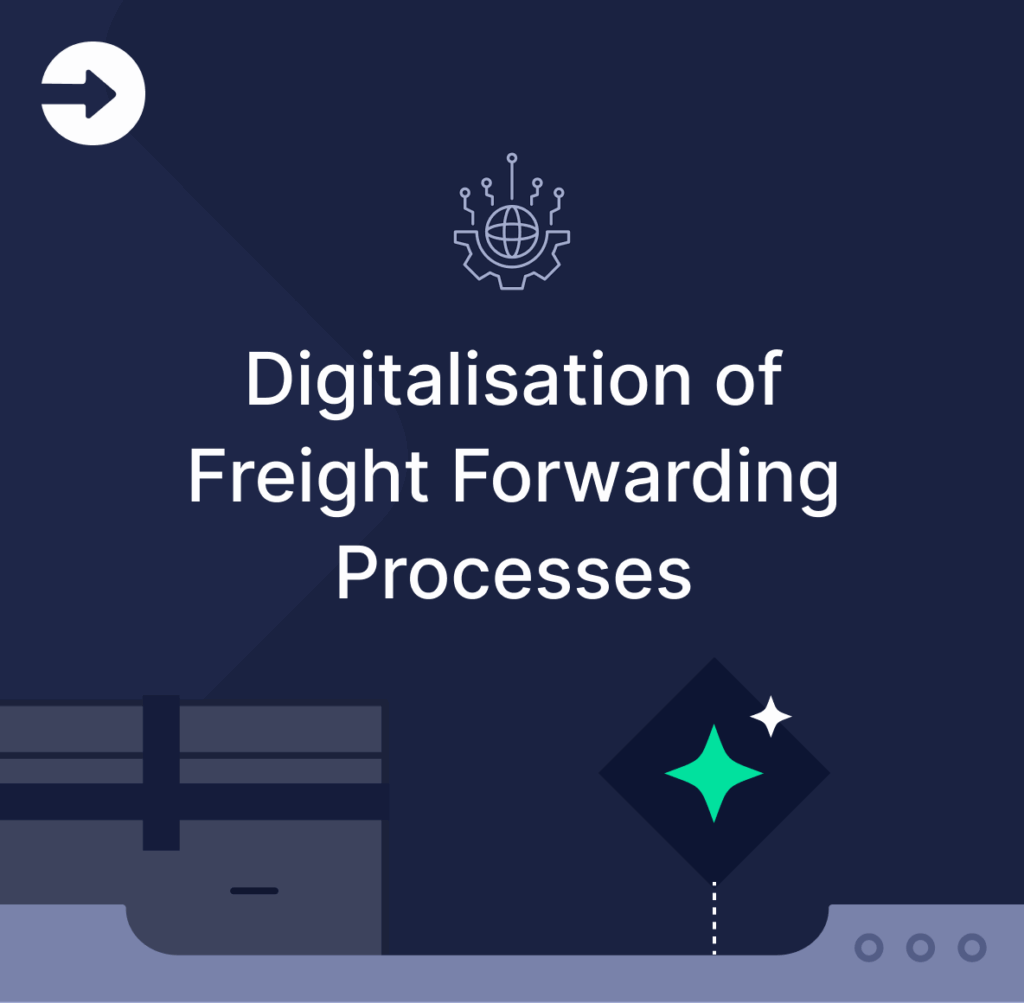Ever wonder why some freight forwarders are landing massive contracts while you’re stuck fighting over table scraps? Or why certain companies handle triple your volume with the same team size?
Here’s the truth: it’s not luck, connections, or rock-bottom pricing. It’s digital freight forwarding and if you’re still sitting on the fence, 2025 might be the year you watch your competitors drive away with your customers.
Let’s talk straight about what’s really happening in logistics right now, why billions are flooding into digital solutions, and what this means for your sales numbers and profit margins.
The Traditional Model is Dying Fast
What’s Really Happening Right Now
Picture your typical Monday morning: spreadsheets everywhere, chasing carriers for rates, typing the same shipment info into five different systems, and answering endless “where’s my cargo?” calls.
Meanwhile, your competitor across town? They’re closing deals in minutes. Their customers track everything from their phones. Their prices adjust automatically to market shifts. They’ve already booked three new shipments while you’re still working on yesterday’s quotes.
This isn’t some future scenario it’s happening today in 2025. The old model of phone calls, endless emails, and manual processes is dead. You’re racing on a bicycle while everyone else drives Ferraris.

Your Customers Have Already Moved On
Your customers changed, even if you didn’t. They track Amazon packages by the minute. They book entire vacations from their phones in seconds. Now they expect the same from you.
When you say “I’ll get back to you tomorrow” on a quote request, they’ve already received three instant quotes from digital platforms. When they want tracking updates and you’re manually checking carrier websites, they’re comparing you to forwarders with real-time GPS and automated notifications.
The gap between what customers expect and what traditional forwarders deliver has never been wider. And it’s costing you deals every single day.

What is Digital Freight Forwarding Anyway?
Cutting Through the Hype
Let’s clear this up fast. Digital freight forwarding isn’t about having a website or replacing faxes with emails (if you’re still using fax, we have bigger problems to discuss).
It means using technology to automate your core processes: quoting, booking, tracking, documentation, and customer communication. Your systems connect with carriers, customers, and partners so information flows automatically, no manual work needed.
Think of it like this: traditional forwarding is doing accounting with pen and paper. Digital forwarding is using QuickBooks. Same work, but 10x faster, way more accurate, and with actual business insights.
Traditional vs Digital: The Truth
Here’s what actually changes when you go digital:
| Traditional Forwarding | Digital Forwarding | Real Impact |
| Manual carrier rate requests | Automated comparison | 10x faster quotes |
| Calling for updates | Real-time integration | Zero wasted time |
| Email chains | Self-service portals | 70% fewer calls |
| Spreadsheet pricing | Smart algorithms | 15-25% better margins |
| Disconnected data | Centralized info | Actual business insights |
Which column describes your operation? More importantly, which describes the forwarders stealing your customers?

Why 2025 is The Tipping Point
E-commerce Changed the Game
E-commerce isn’t slowing down it’s exploding. Statista projects global e-commerce sales hitting $6.3 trillion in 2025. That’s a massive wave of shipments with completely different expectations than traditional B2B freight.
E-commerce shippers demand instant quotes, real-time tracking, and transparent pricing. They’re used to tech in every part of their business. When you offer them old-school forwarding, you’re speaking a language they don’t understand.
The forwarders winning this business? Digital, fast, transparent. Growing at 40-60% while traditional players fight over scraps.
Post-Pandemic Reality
COVID didn’t just mess up supply chains, it changed how logistics works forever. Remote teams, distributed operations, digital-first customer service went from “nice to have” to “must have” overnight.
The survivors weren’t the biggest companies. They were the ones who adapted fast because their systems were already cloud-based and accessible anywhere.

Customer Expectations Exploded
Your customers compare you to every digital experience they have not just other forwarders. When they can get groceries in an hour, track Uber by the second, and run their business from a phone, your manual processes feel ancient.
McKinsey research shows 78% of shippers now prioritize digital capabilities when choosing forwarders. Not price. Not relationships. Digital capabilities. That’s a huge shift from even two years ago.
The Money Talks: Billions Pouring In
Investment Numbers That Matter
Here’s what should wake you up: venture capital poured over $8 billion into digital freight tech in 2024. 2025 is tracking even higher. Smart money doesn’t chase bad bets these investors see the future clearly.
The digital freight market is expected to hit $15.7 billion by 2027, growing at 22% annually. That’s not slow growth that’s explosive transformation.
| Year | Market Size | Growth | What It Means |
| 2023 | $8.2 billion | 18% | Early days |
| 2024 | $10.1 billion | 23% | Going mainstream |
| 2025 | $12.8 billion | 27% | Critical mass hit |
| 2026 | $16.2 billion | 27% | Digital is default |
Who’s Winning Right Now
It’s not just startups. Big traditional forwarders are spending hundreds of millions on digital transformation because they see what’s coming. Flexport, Freightos & Forto these didn’t exist 15 years ago. Now they handle billions in freight.
But here’s the thing: they’re not winning with magic technology. They win by giving customers what they want: speed, transparency, convenience. Technology just makes it possible.
The good news? Mid-sized forwarders using platforms like Cargofive compete effectively against giants by offering digital-first experiences.
How This Boosts Your Revenue
Win More Deals with Digital
When you’re pitching a major account, what do they evaluate? Price matters, sure. But sophisticated shippers know the cheapest quote often becomes the most expensive mistake.
Modern buyers check your digital capabilities seriously. Real-time tracking? Customer portal? System integration? Quote speed?
Sales directors with digital platforms report 35-40% higher win rates because they deliver capabilities traditional competitors can’t touch. You’re not just selling freight services you’re selling peace of mind.
Fix Your Pricing Strategy
Pricing managers, listen up. How much time do you waste building rates manually? Checking contracts, calculating margins, adjusting surcharges, watching markets, hoping you didn’t miss something?
Digital platforms with smart pricing change everything. The system knows your contracts, understands your targets, monitors markets, and generates optimized quotes in seconds, not hours.
Speed Kills (Your Competition)
Brutal truth: you’re losing deals not because your prices suck, but because you’re too slow. By the time you build a quote manually, faster competitors already booked the business.
Harvard Business Review found response time is one of the strongest conversion predictors. Respond in 10 minutes? Your close rate is 5-8x higher than waiting 24 hours. Digital tools make that speed possible without killing accuracy.

Scale Smart, Not Hard
Traditional forwarding has brutal economics: double your volume, add 70-80% more staff. More bookings, more docs, more service, more people.
Digital breaks this cycle. Routine work gets automated, so you handle way more volume with incremental staffing. Cargofive customers commonly double shipments while adding just 20-30% more people.
That’s how you grow margins, not just revenue. That’s how you build real wealth.
What Sales Directors Need to Know
Close Faster, Win Bigger
Imagine walking into a pitch promising instant quotes, real-time tracking, customer portals, and proactive alerts. Now imagine your competitor promising “personal service” and “we’ll call with updates.”
Who wins that deal?
Digital capabilities are competitive weapons. When you demo your platform during sales, showing prospects exactly what they’ll get, you crush traditional competitors.
Sales cycles shrink when you sell real capabilities instead of vague promises. Prospects see and experience the value before signing. That converts skeptics into customers.
What Modern Shippers Really Want
Modern procurement teams have checklists for evaluating forwarders. “Digital capabilities” appears on nearly every one. They ask about APIs, portals, tracking, reporting.
Can’t check those boxes? You’re not making shortlists for major opportunities. You’re fighting for small, unsophisticated shippers while digital competitors chase premium accounts.
The fastest-growing freight segment e-commerce and tech brands won’t even talk to traditional forwarders. They require digital as table stakes.

What Pricing Managers Must Do Now
Dynamic Pricing Can’t Wait
Let’s talk about money left on the table. How often do you quote too high and lose winnable deals? How often do you quote too low and win business that barely breaks even?
Manual pricing causes both constantly because you lack data and tools to optimize. You’re guessing based on experience, which works okay but misses huge margin opportunities.
Dynamic pricing analyzes your history, current markets, competitor rates, customer behavior, and dozens of factors to recommend optimal prices. Not lowest—optimal for winning while protecting margins.
Stop Bleeding Margins
Sobering stat: most forwarders could improve margins 15-20% just by optimizing pricing. They win business they shouldn’t at prices too low, and lose business they should win by pricing too conservatively.
The difference between good and great pricing is often 5-8%, but across hundreds of quotes annually, that’s serious money. A $20M forwarder could capture $3-4M more in gross margin through better pricing alone.
You can’t hit that precision manually. You need systems that learn from every quote and continuously improve.

How Cargofive Makes It Easy
Real Results, Real Fast
At Cargofive, we built our platform to solve exactly what sales directors and pricing managers face daily: slow quotes, limited visibility, manual processes that don’t scale, and brutal digital competition.
Our platform connects everything sales, ops, finance, customers in one system. Salesperson generates a quote? Operations sees it instantly if it converts. Customers get automatic updates without your team lifting a finger. Pricing managers get real-time dashboards showing wins, margins, opportunities.
We’ve already built integrations with major carriers, shipping lines, and customs systems. You’re not starting from scratch, you’re plugging into an existing network that makes you digitally capable from day one.
The Cost of Waiting
Your Window is Closing
Every quarter you delay, customer expectations move further ahead of what you deliver. The gap widens. Catching up gets harder.
Frustrated customers aren’t coming back in two years when you finally go digital. They’re signing multi-year deals with your competitors right now.
That relationship and revenue? Gone, not postponed. Waiting doesn’t just cost growth it means actively losing ground.
The forwarders who started digital transformation two years ago have massive advantages now: better systems, cleaner data, refined processes, customer relationships built on digital service. Catching up isn’t impossible, but it’s way harder than keeping pace would’ve been.
Best time to start? Three years ago. Second best? Today. Worst time? “Eventually.”

Getting Started Today
First Steps That Work
Digital transformation sounds scary, but you don’t need a complete overhaul on day one. Smart forwarders start with high-impact, quick-win moves that deliver immediate value.
Start with customer-facing tools that directly impact sales. Faster quoting so you respond competitively. Real-time tracking giving customers visibility without calls. Customer portal handling routine questions automatically.
These show ROI fast faster sales cycles, better wins, lower service costs—building support for broader change. You don’t need to automate everything overnight. Just start moving in the right direction with initiatives that prove value.
Cargofive helps forwarders prioritize based on specific challenges. For some, pricing tools deliver biggest impact. For others, customer visibility. We’ll help identify your starting point and build from there.
Mistakes That Kill Projects
We’ve seen enough transformations to spot common killers. Avoid these and your odds of success skyrocket.
Don’t build custom from scratch. You’re a forwarder, not a software company. Use proven platforms designed for your industry.
Don’t ignore change management. Technology is easy. Getting your team to embrace it is hard. Invest in training and communication upfront.
Don’t wait for perfect information. You’ll never have complete certainty. Successful forwarders make informed decisions and adjust as they learn.
Don’t cheap out on platforms. Cheap solutions rarely work. The cost difference between mediocre and great is tiny compared to revenue and margin impact.
Conclusion
Digital freight forwarding is exploding in 2025 because it delivers better outcomes for everyone: forwarders, customers, partners.
For sales directors: win more deals with better capabilities. For pricing managers: optimize margins while staying competitive. For operations: scale efficiently without proportional costs. For customers: the visibility, speed, and control they’ve demanded for years.
Winning forwarders today aren’t luckier or better connected they’re digitally capable. They recognized customer expectations changed permanently and built operations to meet those expectations profitably.
At Cargofive, we make digital transformation accessible for forwarders of all sizes. You don’t need to be a tech giant to compete digitally just the right platform, support, and commitment to change.
The explosion of digital freight forwarding in 2025 isn’t happening to the industry it’s something you can lead. The question is whether you’ll step up now while there’s advantage to gain, or scramble later just to keep up.
Choose wisely. The market isn’t waiting.

Frequently Asked Questions
We’re a small forwarder. Is digital transformation really for us or just the big players?
Digital is actually more critical for small and mid-sized forwarders. Big players compete on brand and relationships. You need competitive advantages digital capabilities level the field. With platforms like Cargofive, you offer the same customer experience as giants without massive IT costs. We’ve seen 10-20 person teams compete successfully against international players by delivering better digital experiences. Size doesn’t determine success commitment does.
What does digital transformation actually cost and when do we see ROI?
Modern cloud platforms like Cargofive cost less than one additional employee and typically save 2-3 employees’ worth of time through automation. Most forwarders see measurable ROI within 3-6 months through faster sales cycles, better win rates, improved margins, and lower ops costs. Choose platforms built specifically for freight forwarding, not generic software needing expensive customization. The real question isn’t if you can afford to go digital it’s if you can afford not to while competitors grab market share.
Our customers seem happy with traditional service. Should we still go digital?
Your customers might not ask for digital explicitly, but they feel the friction. Every time they wait hours for quotes, they’re frustrated. Every time they email for updates, they’re wasting time. They’ll appreciate faster responses, better visibility, fewer errors even without requesting “digital transformation.” Plus markets evolve fast. Customers who don’t care today will tomorrow, and prospects you’re chasing definitely care now. Wait until existing customers demand it, and you’ve already lost years of positioning.
We tried new systems before and it failed. How is this different?
Implementation failures usually come from three things: wrong-fit solutions, poor training, or overly complex customization. Modern freight platforms avoid this by being purpose-built for the industry, needing minimal configuration not extensive custom work, and offering comprehensive onboarding. At Cargofive, we’ve learned from thousands of implementations. We guide forwarders through phased rollouts minimizing disruption, provide hands-on training, and offer ongoing support ensuring success. Technology has matured dramatically today’s cloud platforms are exponentially easier than systems from even five years ago.
Do we have to replace everything or can we keep existing systems?
No need to rip everything out. Smart transformation works with existing systems, gradually replacing manual work with integrated digital workflows. Most forwarders keep core accounting or ERP and add digital freight platforms that integrate with them. Start with one area quoting or customer visibility and expand from there. The goal isn’t change for its own sake; it’s strategically automating processes creating competitive advantage. Cargofive integrates with existing systems so you maintain continuity while adding capabilities, not disrupting everything at once
AUTHOR



